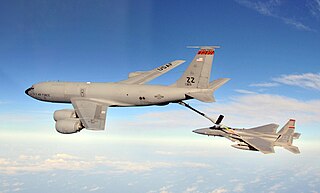
The Boeing KC-135 Stratotanker is an American military aerial refueling tanker aircraft that was developed from the Boeing 367-80 prototype, alongside the Boeing 707 airliner. It has a narrower fuselage and is shorter than the 707. Boeing gave the aircraft the internal designation of Model 717. The KC-135 was the United States Air Force (USAF)'s first jet-powered refueling tanker and replaced the KC-97 Stratofreighter. The KC-135 was initially tasked with refueling strategic bombers, but it was used extensively in the Vietnam War and later conflicts such as Operation Desert Storm to extend the range and endurance of US tactical fighters and bombers.

An aviation accident is defined by the Convention on International Civil Aviation Annex 13 as an occurrence associated with the operation of an aircraft, which takes place from the time any person boards the aircraft with the intention of flight until all such persons have disembarked, and in which (a) a person is fatally or seriously injured, (b) the aircraft sustains significant damage or structural failure, or (c) the aircraft goes missing or becomes completely inaccessible. Annex 13 defines an aviation incident as an occurrence, other than an accident, associated with the operation of an aircraft that affects or could affect the safety of operation.
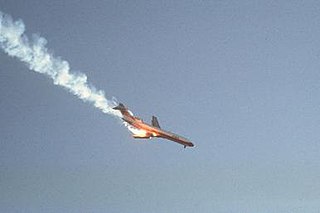
Pacific Southwest Airlines Flight 182 was a scheduled flight of Pacific Southwest Airlines (PSA) from Sacramento to Los Angeles and San Diego. On September 25, 1978, the Boeing 727-214 serving the flight, registration N533PS, collided with a private Cessna 172 light aircraft, registration N7711G, over San Diego, California. It was Pacific Southwest Airlines' first fatal accident, and it remains the deadliest air disaster in California history. At the time, it was the deadliest air crash to occur in the United States, and remained so until American Airlines Flight 191 in May 1979.
This is a list of aviation-related events from 1968.

The Boeing C-97 Stratofreighter was a long-range heavy military cargo aircraft developed from the B-29 and B-50 bombers. Design work began in 1942, the first of three prototype XC-97s flew on 9 November 1944 and the first of six service-test YC-97s flew on 11 March 1947. All nine were based on the 24ST alloy structure and Wright R-3350 engines of the B-29, but with a larger-diameter fuselage upper lobe and they had the B-29 vertical tail with the gunner's position blanked off. The first of three heavily revised YC-97A incorporating the re-engineered wing, taller vertical tail and larger Pratt & Whitney R-4360 engines of the B-50 bomber, flew on 28 January 1948 and was the basis of the subsequent sole YC-97B, all production C-97s, KC-97s and civilian Stratocruiser aircraft. Between 1944 and 1958, 888 C-97s in several versions were built, 811 being KC-97 tankers. C-97s served in the Berlin Airlift, the Korean War, and the Vietnam War. Some aircraft served as flying command posts for the Strategic Air Command, while others were modified for use in Aerospace Rescue and Recovery Squadrons (ARRS).

The Boeing C-135 Stratolifter is a transport aircraft derived from the prototype Boeing 367-80 jet airliner in the early 1950s. It has a narrower fuselage and is shorter than the 707. Boeing gave the aircraft the internal designation of Model 717. Since the first one was built in August 1956, the C-135 and its variants have been a fixture of the United States Air Force.

McConnell Air Force Base is a United States Air Force base located four miles (6 km) southeast of the central business district of Wichita, a city in Sedgwick County, Kansas, United States. The airbase was named in honor of the brothers Fred and Thomas McConnell of Wichita, who had both been Air Force pilots and veterans of World War II. It is the home of Air Mobility Command's 22nd Air Refueling Wing, Air Force Reserve Command's 931st Air Refueling Wing, and the Kansas Air National Guard's 184th Wing.

American Airlines Flight 1 was a regularly scheduled passenger flight from New York International (Idlewild) Airport to Los Angeles International Airport. During the March 1, 1962, operation of the flight, the Boeing 707 executing it rolled over and crashed into Jamaica Bay two minutes after taking off, killing all 87 passengers and eight crew members aboard. A Civil Aeronautics Board investigation determined that a manufacturing defect in the autopilot system led to an uncommanded rudder control system input, causing the accident. A number of notable people died in the crash. It was the fifth fatal Boeing 707 accident, and at the time, the deadliest. It was third of three fatal crashes during an operation of American Airlines Flight 1. Finally, this was the third fatal involving one of American's 707s in the New York area within a three-year period, after Flight 514 and Flight 1502.
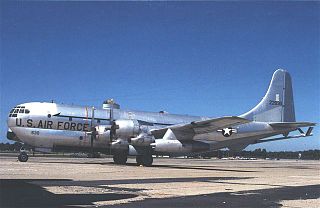
The Boeing KC-97 Stratofreighter is a four-engined, piston-powered United States strategic tanker aircraft based on the Boeing C-97 Stratofreighter. It replaced the KB-29 and was succeeded by the Boeing KC-135 Stratotanker.
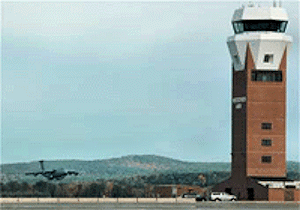
Westover Metropolitan Airport is a civilian airport located in the Massachusetts communities of Chicopee, Granby, and Ludlow, near the cities of Springfield and Holyoke, Massachusetts. The complex is considered intermodal because it borders the Massachusetts Turnpike and is accessible by several industrial rail spurs. It was named for General Oscar Westover, commanding officer of the Army Air Corps in the 1930s.

Clinton-Sherman Air Force Base (1954–1969) is a former United States Air Force Strategic Air Command base located near the town of Burns Flat in Washita County, Oklahoma, 15 miles (24 km) southwest of the city of Clinton, Oklahoma. Today it is the site of the Clinton-Sherman Industrial Airpark.

Trans-Canada Air Lines (TCA) Flight 831 was a flight from Montréal–Dorval International Airport to Toronto International Airport on November 29, 1963. About five minutes after takeoff in poor weather, the jet crashed about 32 km (20 mi) north of Montreal, near Ste-Thérèse-de-Blainville, Quebec, Canada, killing all 111 passengers and seven crew members. The crash was the deadliest in Canadian history at the time. It was also the deadliest crash of a DC-8 at the time, and, as of 2022, the sixth-deadliest.
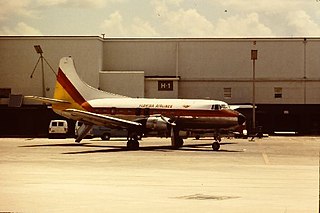
In clear and calm weather in Colorado at 1:14 p.m. MDT on Friday, October 2, 1970, a chartered Martin 4-0-4 airliner crashed into a mountain eight miles (13 km) west of Silver Plume. Operated by Golden Eagle Aviation, the twin-engined propliner carried 37 passengers and a crew of three; 29 were killed at the scene and two later died of their injuries while under medical care.

The Bakers Creek air crash was an aviation disaster that occurred on 14 June 1943, when a United States Army Air Forces (USAAF) Boeing B-17 Flying Fortress aircraft crashed at Bakers Creek, Queensland, Australia. The aircraft took off from Mackay and crashed approximately 8 km south of the airfield. Forty military service personnel on board were killed; one person survived the crash. The crash is Australia's deadliest aviation disaster by death toll and was the deadliest accident involving a transport aircraft in the south-western Pacific during World War II.

The 350th Air Refueling Squadron is a United States Air Force unit assigned to the 22nd Air Refueling Wing at McConnell Air Force Base, Kansas. It operates Boeing KC-135 Stratotanker aircraft conducting air refueling missions.

Mount Kit Carson is a mountain in the northwest United States, located in Spokane County, Washington, northeast of Spokane, with a summit elevation of 5,286 feet (1,611 m) above sea level. It is in Mount Spokane State Park, the largest of Washington's State Parks at 13,919 acres.
The history of Wichita details the history of Wichita, Kansas from its initial settlement in the 1860s to the present day.

On 10 July 2017, a Lockheed KC-130T Hercules aircraft of the United States Marine Corps (USMC) crashed in Leflore County, Mississippi, killing all 16 people on board. The aircraft had the call sign "Yanky 72" and was from Marine Aerial Refueler Transport Squadron 452 (VMGR-452) based at Stewart Air National Guard Base, New York. Debris from the aircraft was found in Leflore County, Mississippi. The USMC released a statement calling the event a "mishap."

On June 27, 1958, a Boeing KC-135 Stratotanker attempting to break a world speed record crashed shortly after takeoff from Westover Air Force Base, killing all 15 aboard the plane.


















